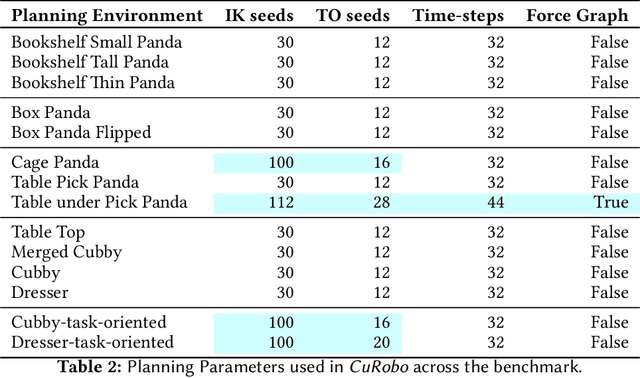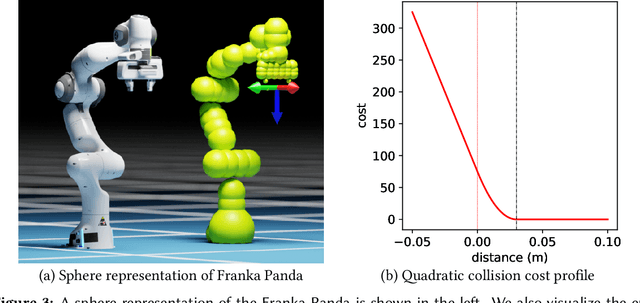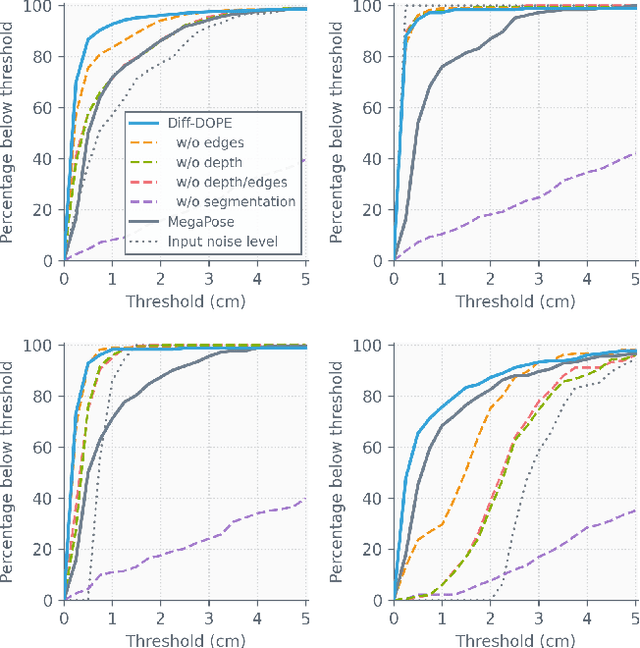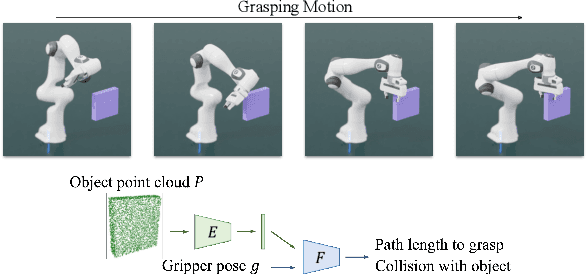Balakumar Sundaralingam
GraspGen: A Diffusion-based Framework for 6-DOF Grasping with On-Generator Training
Jul 17, 2025Abstract:Grasping is a fundamental robot skill, yet despite significant research advancements, learning-based 6-DOF grasping approaches are still not turnkey and struggle to generalize across different embodiments and in-the-wild settings. We build upon the recent success on modeling the object-centric grasp generation process as an iterative diffusion process. Our proposed framework, GraspGen, consists of a DiffusionTransformer architecture that enhances grasp generation, paired with an efficient discriminator to score and filter sampled grasps. We introduce a novel and performant on-generator training recipe for the discriminator. To scale GraspGen to both objects and grippers, we release a new simulated dataset consisting of over 53 million grasps. We demonstrate that GraspGen outperforms prior methods in simulations with singulated objects across different grippers, achieves state-of-the-art performance on the FetchBench grasping benchmark, and performs well on a real robot with noisy visual observations.
Dynamic Non-Prehensile Object Transport via Model-Predictive Reinforcement Learning
Nov 27, 2024



Abstract:We investigate the problem of teaching a robot manipulator to perform dynamic non-prehensile object transport, also known as the `robot waiter' task, from a limited set of real-world demonstrations. We propose an approach that combines batch reinforcement learning (RL) with model-predictive control (MPC) by pretraining an ensemble of value functions from demonstration data, and utilizing them online within an uncertainty-aware MPC scheme to ensure robustness to limited data coverage. Our approach is straightforward to integrate with off-the-shelf MPC frameworks and enables learning solely from task space demonstrations with sparsely labeled transitions, while leveraging MPC to ensure smooth joint space motions and constraint satisfaction. We validate the proposed approach through extensive simulated and real-world experiments on a Franka Panda robot performing the robot waiter task and demonstrate robust deployment of value functions learned from 50-100 demonstrations. Furthermore, our approach enables generalization to novel objects not seen during training and can improve upon suboptimal demonstrations. We believe that such a framework can reduce the burden of providing extensive demonstrations and facilitate rapid training of robot manipulators to perform non-prehensile manipulation tasks. Project videos and supplementary material can be found at: https://sites.google.com/view/cvmpc.
Inference-Time Policy Steering through Human Interactions
Nov 25, 2024



Abstract:Generative policies trained with human demonstrations can autonomously accomplish multimodal, long-horizon tasks. However, during inference, humans are often removed from the policy execution loop, limiting the ability to guide a pre-trained policy towards a specific sub-goal or trajectory shape among multiple predictions. Naive human intervention may inadvertently exacerbate distribution shift, leading to constraint violations or execution failures. To better align policy output with human intent without inducing out-of-distribution errors, we propose an Inference-Time Policy Steering (ITPS) framework that leverages human interactions to bias the generative sampling process, rather than fine-tuning the policy on interaction data. We evaluate ITPS across three simulated and real-world benchmarks, testing three forms of human interaction and associated alignment distance metrics. Among six sampling strategies, our proposed stochastic sampling with diffusion policy achieves the best trade-off between alignment and distribution shift. Videos are available at https://yanweiw.github.io/itps/.
DiffusionSeeder: Seeding Motion Optimization with Diffusion for Rapid Motion Planning
Oct 22, 2024Abstract:Running optimization across many parallel seeds leveraging GPU compute have relaxed the need for a good initialization, but this can fail if the problem is highly non-convex as all seeds could get stuck in local minima. One such setting is collision-free motion optimization for robot manipulation, where optimization converges quickly on easy problems but struggle in obstacle dense environments (e.g., a cluttered cabinet or table). In these situations, graph-based planning algorithms are used to obtain seeds, resulting in significant slowdowns. We propose DiffusionSeeder, a diffusion based approach that generates trajectories to seed motion optimization for rapid robot motion planning. DiffusionSeeder takes the initial depth image observation of the scene and generates high quality, multi-modal trajectories that are then fine-tuned with a few iterations of motion optimization. We integrate DiffusionSeeder to generate the seed trajectories for cuRobo, a GPU-accelerated motion optimization method, which results in 12x speed up on average, and 36x speed up for more complicated problems, while achieving 10% higher success rate in partially observed simulation environments. Our results show the effectiveness of using diverse solutions from a learned diffusion model. Physical experiments on a Franka robot demonstrate the sim2real transfer of DiffusionSeeder to the real robot, with an average success rate of 86% and planning time of 26ms, improving on cuRobo by 51% higher success rate while also being 2.5x faster.
cuRobo: Parallelized Collision-Free Minimum-Jerk Robot Motion Generation
Nov 03, 2023



Abstract:This paper explores the problem of collision-free motion generation for manipulators by formulating it as a global motion optimization problem. We develop a parallel optimization technique to solve this problem and demonstrate its effectiveness on massively parallel GPUs. We show that combining simple optimization techniques with many parallel seeds leads to solving difficult motion generation problems within 50ms on average, 60x faster than state-of-the-art (SOTA) trajectory optimization methods. We achieve SOTA performance by combining L-BFGS step direction estimation with a novel parallel noisy line search scheme and a particle-based optimization solver. To further aid trajectory optimization, we develop a parallel geometric planner that plans within 20ms and also introduce a collision-free IK solver that can solve over 7000 queries/s. We package our contributions into a state of the art GPU accelerated motion generation library, cuRobo and release it to enrich the robotics community. Additional details are available at https://curobo.org
VaPr: Variable-Precision Tensors to Accelerate Robot Motion Planning
Oct 11, 2023



Abstract:High-dimensional motion generation requires numerical precision for smooth, collision-free solutions. Typically, double-precision or single-precision floating-point (FP) formats are utilized. Using these for big tensors imposes a strain on the memory bandwidth provided by the devices and alters the memory footprint, hence limiting their applicability to low-power edge devices needed for mobile robots. The uniform application of reduced precision can be advantageous but severely degrades solutions. Using decreased precision data types for important tensors, we propose to accelerate motion generation by removing memory bottlenecks. We propose variable-precision (VaPr) search optimization to determine the appropriate precision for large tensors from a vast search space of approximately 4 million unique combinations for FP data types across the tensors. To obtain the efficiency gains, we exploit existing platform support for an out-of-the-box GPU speedup and evaluate prospective precision converter units for GPU types that are not currently supported. Our experimental results on 800 planning problems for the Franka Panda robot on the MotionBenchmaker dataset across 8 environments show that a 4-bit FP format is sufficient for the largest set of tensors in the motion generation stack. With the software-only solution, VaPr achieves 6.3% and 6.3% speedups on average for a significant portion of motion generation over the SOTA solution (CuRobo) on Jetson Orin and RTX2080 Ti GPU, respectively, and 9.9%, 17.7% speedups with the FP converter.
Diff-DOPE: Differentiable Deep Object Pose Estimation
Sep 30, 2023



Abstract:We introduce Diff-DOPE, a 6-DoF pose refiner that takes as input an image, a 3D textured model of an object, and an initial pose of the object. The method uses differentiable rendering to update the object pose to minimize the visual error between the image and the projection of the model. We show that this simple, yet effective, idea is able to achieve state-of-the-art results on pose estimation datasets. Our approach is a departure from recent methods in which the pose refiner is a deep neural network trained on a large synthetic dataset to map inputs to refinement steps. Rather, our use of differentiable rendering allows us to avoid training altogether. Our approach performs multiple gradient descent optimizations in parallel with different random learning rates to avoid local minima from symmetric objects, similar appearances, or wrong step size. Various modalities can be used, e.g., RGB, depth, intensity edges, and object segmentation masks. We present experiments examining the effect of various choices, showing that the best results are found when the RGB image is accompanied by an object mask and depth image to guide the optimization process.
Meta-Policy Learning over Plan Ensembles for Robust Articulated Object Manipulation
Jul 08, 2023



Abstract:Recent work has shown that complex manipulation skills, such as pushing or pouring, can be learned through state-of-the-art learning based techniques, such as Reinforcement Learning (RL). However, these methods often have high sample-complexity, are susceptible to domain changes, and produce unsafe motions that a robot should not perform. On the other hand, purely geometric model-based planning can produce complex behaviors that satisfy all the geometric constraints of the robot but might not be dynamically feasible for a given environment. In this work, we leverage a geometric model-based planner to build a mixture of path-policies on which a task-specific meta-policy can be learned to complete the task. In our results, we demonstrate that a successful meta-policy can be learned to push a door, while requiring little data and being robust to model uncertainty of the environment. We tested our method on a 7-DOF Franka-Emika Robot pushing a cabinet door in simulation.
DeXtreme: Transfer of Agile In-hand Manipulation from Simulation to Reality
Oct 25, 2022Abstract:Recent work has demonstrated the ability of deep reinforcement learning (RL) algorithms to learn complex robotic behaviours in simulation, including in the domain of multi-fingered manipulation. However, such models can be challenging to transfer to the real world due to the gap between simulation and reality. In this paper, we present our techniques to train a) a policy that can perform robust dexterous manipulation on an anthropomorphic robot hand and b) a robust pose estimator suitable for providing reliable real-time information on the state of the object being manipulated. Our policies are trained to adapt to a wide range of conditions in simulation. Consequently, our vision-based policies significantly outperform the best vision policies in the literature on the same reorientation task and are competitive with policies that are given privileged state information via motion capture systems. Our work reaffirms the possibilities of sim-to-real transfer for dexterous manipulation in diverse kinds of hardware and simulator setups, and in our case, with the Allegro Hand and Isaac Gym GPU-based simulation. Furthermore, it opens up possibilities for researchers to achieve such results with commonly-available, affordable robot hands and cameras. Videos of the resulting policy and supplementary information, including experiments and demos, can be found at \url{https://dextreme.org/}
Neural Motion Fields: Encoding Grasp Trajectories as Implicit Value Functions
Jun 29, 2022



Abstract:The pipeline of current robotic pick-and-place methods typically consists of several stages: grasp pose detection, finding inverse kinematic solutions for the detected poses, planning a collision-free trajectory, and then executing the open-loop trajectory to the grasp pose with a low-level tracking controller. While these grasping methods have shown good performance on grasping static objects on a table-top, the problem of grasping dynamic objects in constrained environments remains an open problem. We present Neural Motion Fields, a novel object representation which encodes both object point clouds and the relative task trajectories as an implicit value function parameterized by a neural network. This object-centric representation models a continuous distribution over the SE(3) space and allows us to perform grasping reactively by leveraging sampling-based MPC to optimize this value function.
 Add to Chrome
Add to Chrome Add to Firefox
Add to Firefox Add to Edge
Add to Edge